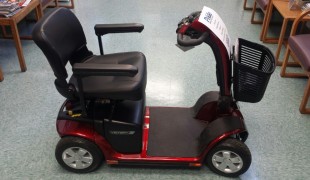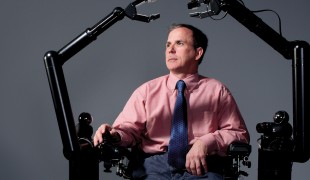- 7063
- 508
- 13
- 13
- 1
- Help Ukraine
About the solution
The young boy is dependent on his father to be ferried around. Because his father is not always available, sometimes Nikhil misses classes. With this in mind, Mayuri took action and created a solution.
“My brother is growing up, and it is not comfortable and convenient for my father to lift him and hold him on the scooter every time he goes to school. At times when my father is not around, he misses his classes. So I thought of this idea to take my brother to school with me and discussed it with my teachers and principal and everyone gladly supported me”, she explained.
The girl had the idea of connecting a cycle to a wheelchair. With the help of her teachers and the school’s technical, team, she welded a cycle to the wheelchair, making some modifications so that the boy can be safe. It took the team one week to finish this project.
The device works by having the brake system of the cycle connected to the wheel both of the cycle and the wheelchair. They’ve installed a belt to ensure the user’s safety.
Adapted from: http://bit.do/eRoty
这些解决方案不应包括使用药物,化学品或生物制品(包括食品);创伤性设备;冒犯性的,商业或内在危险的内容。该解决方案未经医学验证。请谨慎进行!如果您有任何疑问,请咨询健康专家。
DISCLAIMER: This story was written by someone who is not the author of the solution, therefore please be advised that, although it was written with the utmost respect for the innovation and the innovator, there can be some incorrect statements. If you find any errors please contact the patient Innovation team via info@patient-innovation.com
-
-
633
-
0
-
8827

Drive-Master - adaptive mobility equipment
MOVING IN A WHEELCHAIR: Moving using a wheelchair.
WALKING WITH A WALKING AID: Walking with a walking aid
CAREGIVING
Polio
Assistive Daily Life Device (to help ADL)
Walking Aid (wheelchair/walker/crutches)
Muscle cramps or spasms
Difficulty coordinating movements
Stiffness or rigidity (difficulty moving)
Paralysis of the legs and lower body
Muscle weakness
Restoring mobility
Promoting self-management
Managing Neurological Disorders
Promoting inclusivity and social integration
Caregiving Support
Neurology
Physical Medicine and Rehabilitation
Rheumatology
United States
-
-
-
515
-
0
-
7389

Scooter for disabled people
MOVING IN A WHEELCHAIR: Moving using a wheelchair.
CAREGIVING
Amyotrophic Lateral Sclerosis
Assistive Daily Life Device (to help ADL)
Walking Aid (wheelchair/walker/crutches)
Gait abnormalities (e.g., walking difficulties, unsteady gait)
Muscle cramps or spasms
Difficulty coordinating movements
Stiffness or rigidity (difficulty moving)
Paralysis of the legs and lower body
Muscle weakness
Fatigue
Restoring mobility
Promoting self-management
Rehabilitating After Stroke
Managing Neurological Disorders
Promoting inclusivity and social integration
Preventing (Vaccination, Protection, Falls, Research/Mapping)
Caregiving Support
Neurology
Orthopedics
Rheumatology
United States
-
-
-
455
-
0
-
7309

Paralyzed man designs innovative wheelchairs
CAREGIVING
MOVING IN A WHEELCHAIR: Moving using a wheelchair.
Grip
Rubgy
Basketball
Paralysis
Cervical spinal cord injury/Tetraplegia
Assistive Daily Life Device (to help ADL)
Assistive Technology access
Walking Aid (wheelchair/walker/crutches)
Restoring mobility
Replacing lost limbs
Promoting self-management
Promoting inclusivity and social integration
Recovering from Traumatic Injuries
Preventing (Vaccination, Protection, Falls, Research/Mapping)
Caregiving Support
Neurology
Orthopedics
Physical Medicine and Rehabilitation
United States
-
 zh
zh
Ronyz Reynald • Mon, 07/29/2019 - 12:36